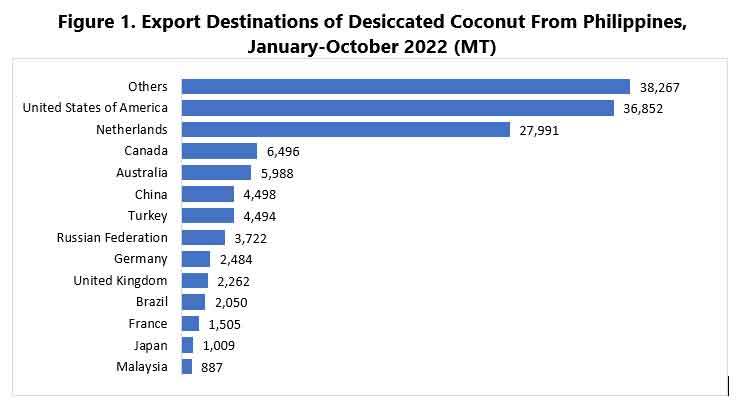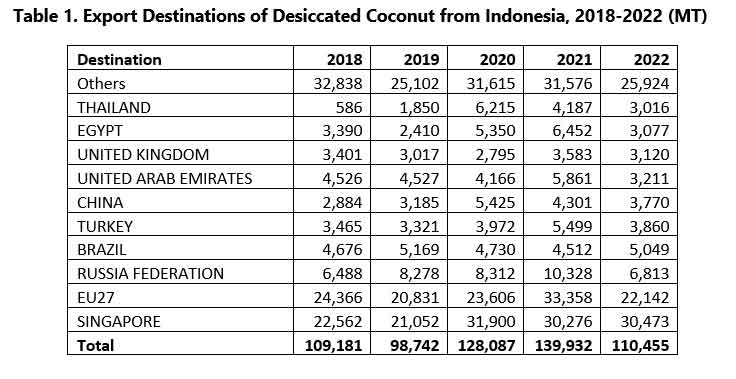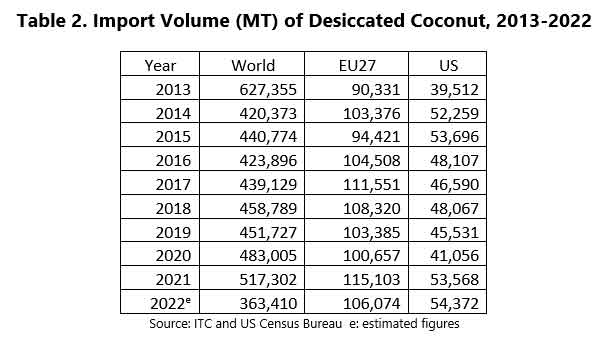- Home
- Statistics
- Market Review
Market Review of Dessicated Coconut
February 2023
The global demand for desiccated coconut is on the rise and the Philippines and Indonesia are two of the world's major producers and exporters of this commodity. According to data from the Philippine Statistics Authority, the country's exports of desiccated coconut showed an upward trend from 2019 to 2022. In 2019, the country exported 147,594 metric tons of desiccated coconut, which declined slightly to 145,200 metric tons in 2020 but then rose to 160,117 metric tons in 2021. The latest data shows that the trend continues to climb, with estimated export volume of 163,169 metric tons in 2022.
In terms of export destinations, the data for the period of January-October 2022 shows that the top countries to which the Philippines exported desiccated coconut were the United States of America, with 36,852 metric tons, and the Netherlands, with 27,991 metric tons. Other major destinations included Canada, Australia, China, and Turkey which all imported over 4,000 metric tons each. This data suggests that the demand for desiccated coconut is strong in North America and Europe, as well as in Asia.

Meanwhile, Indonesia's exports of desiccated coconut saw a decline in 2019 but have since rebounded. In 2018, Indonesia exported 109,181 metric tons of desiccated coconut, which decreased to 98,742 metric tons in 2019 and then increased to 128,087 metric tons in 2020. In 2021, Indonesia's exports of desiccated coconut continued to climb, reaching 139,932 metric tons. However, the latest data for 2022 shows a decline to 110,455 metric tons. When looking at export destinations, Indonesia's main export markets for desiccated coconut are the European Union (EU27), followed by Singapore and Russia Federation. China and Brazil are also significant importers of Indonesian desiccated coconut. It is worth noting that in 2022, the volume of exports to all these major destinations has declined compared to 2021.

Overall, the data suggests that the demand for desiccated coconut remains strong in various regions of the world. While the pandemic has caused some fluctuations in the volume of exports, both the Philippines and Indonesia have seen an upward trend in their exports of desiccated coconut over the past few years. With the growing awareness of the health benefits of coconut products, it is likely that the demand for desiccated coconut will continue to increase, making it an important commodity for these two countries and their respective economies.
Examining the latest data on imports demand, it is expected that there has been a significant decrease in global imports of desiccated coconut in metric tons from 2021 to 2022, with a decrease of 29.7%. This decrease mostly driven by the declining demand in European countries. Imports of the product by EU27 dropped by 7.8% during CY2022. However, US imports was still increasing by 1.5%. This suggests that supply chain disruptions especially in European continent have significantly affected demand of the product worsened by expected global economic slowdown incoming years.

However, when we look at the overall trend for the last 10 years, there has been a slight increase in demand of desiccated coconut in EU27 and US. This suggests that while there may be short-term fluctuations in import levels, the overall demand for desiccated coconut has remained relatively stable over the long term. In fact, over the last decade, imports of desiccated coconut by the two major regions, UE27 and US, have increased with CAGR of 1.8% and 3.6% respectively.
Desiccated coconut (DC) prices showed a decreasing trend throughout 2022, with prices in the Philippines, Indonesia, and Sri Lanka all experiencing drops. In February 2022, the price of DC in the Philippines was at its highest for the year, reaching US$2,721/MT, but by January 2023, it had decreased to US$1,874/MT. Similarly, in Indonesia and Sri Lanka, prices decreased by 29% and 21%, respectively, over the last twelve months.
One factor that may have contributed to the decreasing trend in DC prices is the high inflation rate in several European countries and the USA. This could have reduced consumer purchasing power, leading to a decrease in demand for coconut products, including desiccated coconut. Additionally, an expected economic slowdown in the coming year could also be a contributing factor.

